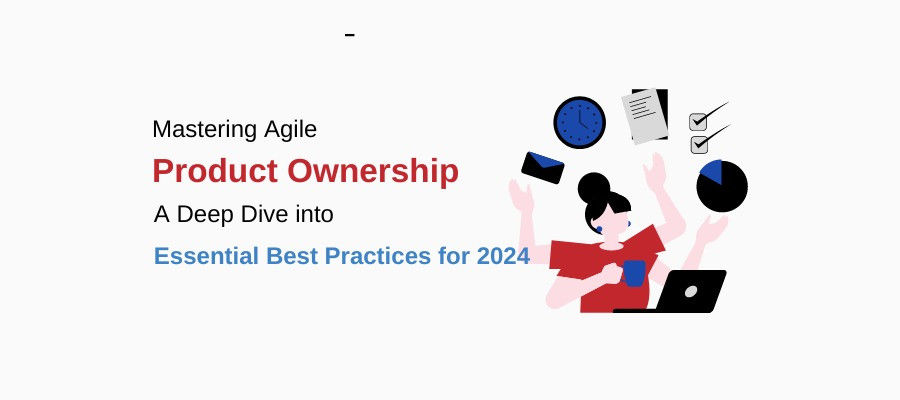Mastering Agile Product Ownership: A Deep Dive Into Essential Best Practices For 2024

Are you an aspiring Agile Product Owner? Then, you must prepare to become the Certified Scrum Product Owner in 2024! Even though it’s a great start to begin your 2024 preparation, you must explore the essential best practices to achieve successful Product Ownership. This is what it takes to complete a product development journey with a successful Product Release. But what does mastering Agile Product Ownership mean for Agile Leaders? Let's help you master the best approaches to Agile Product Ownership in 2024.
The Essence of Agile Product Ownership: What Does It Mean?
Agile Product Ownership encapsulates the art of navigating product development with agility and a clear Product Vision. It's more than just managing a Product Backlog; it's about understanding customer needs and prioritizing Feature Releases accordingly.
As an Agile Product Owner, you mediate between the Scrum Team and the Business Stakeholders. While you drive the Agile Developers for the end Product Goal, you keep the stakeholders updated about the development process. You take the entire Product Ownership and ensure the Product Roadmap aligns with the end-user expectations. Embracing this role means embracing change with Continuous Learning.
Why Is The Role Of A Product Owner Crucial For The Team’s Success?
Keep reading the following factors that highlight the importance of a Product Owner’s role in an Agile Organization:
- Voice of the Customer: Represent the user's need to create the Product Roadmap.
- Strategic Visionary: Craft the Product Vision and acceptance/validation criteria.
- Ownership & Accountability: Manage the Product Backlog based on the project scope.
- Decision-Maker: Possess veto authority to finalize what aligns with the Product Goal.
- Continuous Feedback: Regularly check progress with teams through Sprint Reviews.
Hence, the CSPO plays a vital role in taking the Agile Product Ownership and achieving team excellence to deliver the expected business value team excellence.
Essential CSPO Best Practices For Agile Product Ownership:
Let’s look at the best practices that Product Owners must follow to manage the Product Backlog and prioritize User Stories for immediate Releases. So, you must also follow these best practices for Agile Product Ownership in 2024!
1. Define Clear Objectives
The Product Owner develops the Product Roadmap based on the Product Vision. Once he confirms the user requirements and business objectives, he aligns the expectations with the final Product Goal. So, it’s best to define clear roles and responsibilities of Developers and the Scrum Team for each Sprint. When everyone agrees with the Sprint Goal, they can efficiently work on the dedicated Features and User Stories during the Sprint.
2. Follow A Collaborative Approach
Embrace collaboration with the Scrum Team and Agile Developers through Daily Scrum and Sprint Retrospective. As an Agile Product Owner, take part in Daily Scrums alongside the Scrum Master to keep the communication channels open for all. Accept stakeholders’ feedback to inform the Developers whether they are going in the right direction. As everyone works with a shared understanding of the Product Vision, achieving the ultimate project objectives becomes easier.
3. Prioritize User Stories Effectively
It’s best to prioritize User Stories by assigning business value to each. The CSPO must translate market research analysis to prioritize items from the Product Backlog and bring them on the current Sprint. Techniques like the MoSCoW method or Value vs. Effort analysis help prioritize User Stories in the Product Backlog. Remember, not all PBIs are created equal. So, you must allocate resources and do capacity planning wisely.
4. Define Ready and Done Criteria
Establish a clear 'Definition of Ready' for PBIs entering the Sprint Backlog. Similarly, articulate the 'Definition of Done' to ensure the Scrum Team understands the criteria for a feature or enhancement to be considered complete and releasable. Adhere to the Definition of Ready for each User Story and ensure backlogs are available for the coming two to three sprints. Ensure smooth Product Roadmap profession with the Definition of Ready metric.
5. Continuous Learning To Empower the Scrum Team
Trust your Agile Developers and Scrum Master. As an Agile Leader, create an environment where the Scrum Team feels valued and motivated to deliver high-quality Increments. Invest in Agile Training and Scrum Training for yourself and the Scrum Team. Engage with Agile Coaches and practitioners from PremierAgile or other reputable organizations to stay updated with industry trends and best practices.
The Journey Ahead:
Mastering Agile Product Ownership requires a blend of technical expertise with continuous improvement. Remember, transformation is a constant process to overcome the complexities of Agile Product Ownership in 2024. Embrace the role of an Agile Practitioner with enthusiasm and dedication. By embracing best practices, you can empower your Scrum Team to navigate the challenges of modern product development with confidence and agility.
So, are you ready to elevate your Agile Product Ownership skills and lead your organization to new heights in 2024? Embrace the Agile Product Ownership journey with the essential best practices!



